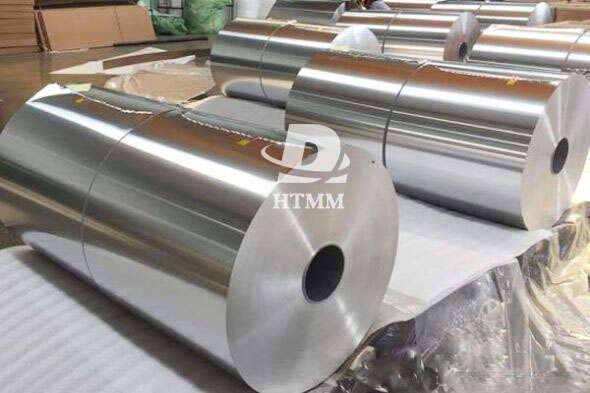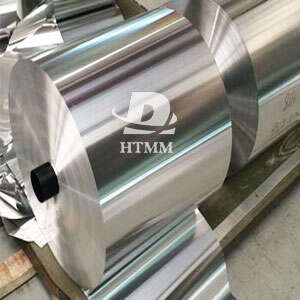Single-zero aluminum alloy foil is a metal material with excellent properties. It is widely used in packaging, electronics, construction and other fields in our daily life.
First of all, I will introduce to you who are reading the production process of single-zero aluminum alloy foil, which requires many complicated processes.
First, our factory must prepare raw materials. The primary raw material for making single-zero aluminum alloy foil is high-purity aluminum billet. These aluminum billets can be obtained through two methods: one is to smelt aluminum metal through alumina reduction; the other is to recycle and remelt scrap aluminum products to obtain aluminum metal. Next, we will put the prepared aluminum billet into the smelting furnace for smelting. Generally, electrolytic furnaces or molten salt furnaces are used to smelt aluminum. A certain proportion of alloying elements, such as silicon, copper, zinc, etc., are added during smelting. These alloying elements can change the properties of aluminum and improve the strength and corrosion resistance of alloy foils. Then workshop workers will cast the smelted aluminum liquid through the continuous casting machine, and pour the liquid aluminum into the crystallizer of the continuous casting machine. The cooling water in the crystallizer causes the liquid aluminum to quickly solidify into an aluminum billet. The thickness of the aluminum billet is determined according to the required thickness of the aluminum alloy foil. After continuous casting, the aluminum billet is rolled up tightly by a steel winding machine and stretched by a tractor to maintain the consistency and flatness of the alloy foil. After passing through the continuous casting process, the aluminum billet also undergoes heating and homogenization treatment through multi-pass billet controlled rolling. The purpose of this step is to eliminate the stress inside the aluminum billet, improve the plasticity of the material, and prepare for the subsequent rolling process.
Then the workshop master will perform three rolling processes on the aluminum billet. The aluminum billet that has been heated and homogenized must first enter the rough rolling mill for rough rolling, which is one of the key links in alloy foil preparation. Rough rolling is to gradually roll the aluminum billet into the required alloy foil thickness through multi-pass rolling. It also provides good process conditions for the next rolling process. After rough rolling, the alloy foil enters the intermediate rolling mill for intermediate rolling. Intermediate rolling is to further reduce the thickness of the alloy foil through multi-pass roller rolling to form a more uniform foil. After intermediate rolling, further finishing rolling operations are required. Finish rolling is to further reduce the thickness of the alloy foil to the required size through multi-pass roller rolling. Finish rolling requires a more stringent rolling process to ensure the dimensional accuracy and surface quality of the alloy foil. These three processes are the most important part of controlling the thickness of aluminum foil. They not only increase the cost of investment in the processing process, but also satisfy customers' guarantee of aluminum foil quality.

After multiple passes of rolling, the alloy foil will be subject to strong stress and needs to be annealed. Annealing is to heat the rolled alloy foil to a certain temperature, then maintain it at a constant temperature for a period of time, and then gradually cool it. Annealing can eliminate the stress inside the foil and improve the deformation performance of the alloy foil. The annealed alloy foil undergoes surface treatment. Surface treatment includes cleaning and chemical treatments. Cleaning can remove oil stains and impurities on the surface of alloy foil, making it cleaner. For chemical treatment, we will use pickling and alkali cleaning to improve the surface finish and corrosion resistance of the alloy foil.
Finally, the surface-treated alloy foil will be cut into the width required by the customer, and the alloy foil will be rolled into a roll through a coiler. The rolled alloy foil can be further processed, such as cut into sheets of required size or rolled into rolls for packaging. These are the series of processes we have to go through when making single-zero aluminum alloy foil. We can not only obtain high-quality single-zero aluminum alloy foil, but also meet our needs in different areas of life.
There may be many consumers who are concerned about the quality standards of single-zero aluminum alloy foil. The quality standards and requirements for aluminum and aluminum alloy foils are mainly formulated by the International Organization for Standardization (ISO) and national standards organizations. Below are the standards set by several countries (organizations) that I have listed for you who are reading this article.
1. ISO 209-1:2019 - General requirements for chemical composition and mechanical properties of aluminum and aluminum alloy plates, strips and foils
This standard specifies the chemical composition, physical properties, mechanical properties and other quality requirements for aluminum and aluminum alloy plates, strips and foils.
2. ISO 209-2:2019 - Dimensions and tolerances of aluminum and aluminum alloy plates, strips and foils
This standard specifies dimensional ranges, tolerances and surface quality requirements for aluminum and aluminum alloy plates, strips and foils.
3. ASTM B209 - Standard Specification for General Requirements for Aluminum and Aluminum Alloy Plate and Foil
This American Society for Testing and Materials (ASTM) standard specifies the chemical composition, physical properties, mechanical properties, and other quality requirements for aluminum and aluminum alloy plates and foils.
4. GB/T 3880 - Aluminum and aluminum alloy plates, strips and foils
This is the standard for aluminum and aluminum alloy plates, strips and foils formulated by the Chinese National Standard (GB), which stipulates the chemical composition, physical properties, mechanical properties and other requirements of aluminum and aluminum alloy plates, strips and foils.
In addition, there may be specially formulated industry standards or enterprise standards in different industries and application fields. According to specific needs, you can refer to the corresponding industry or enterprise standards. When purchasing aluminum and aluminum alloy foils, we, consumers, are advised to choose products that meet relevant standards based on specific application needs.
Many consumers using single-zero aluminum alloy foil will cause unnecessary material loss due to improper operation. Therefore, in this paragraph, I will explain to consumers their personal suggestions during use. Single-zero aluminum alloy foil has excellent performance, but during use, consumers need to master certain methods and techniques to ensure that it functions safely and efficiently.
Prior to purchase, customers should select individual aluminum alloy plates that are the right size and thickness. Too thick or too thin of paper could not perform properly or meet the requirements of the application. Customers should select dimensions such as thickness and breadth based on their intended application. Customers also need to make sure that the surface is of a high caliber when they use it. Keep pollutants and surface damage at bay.







